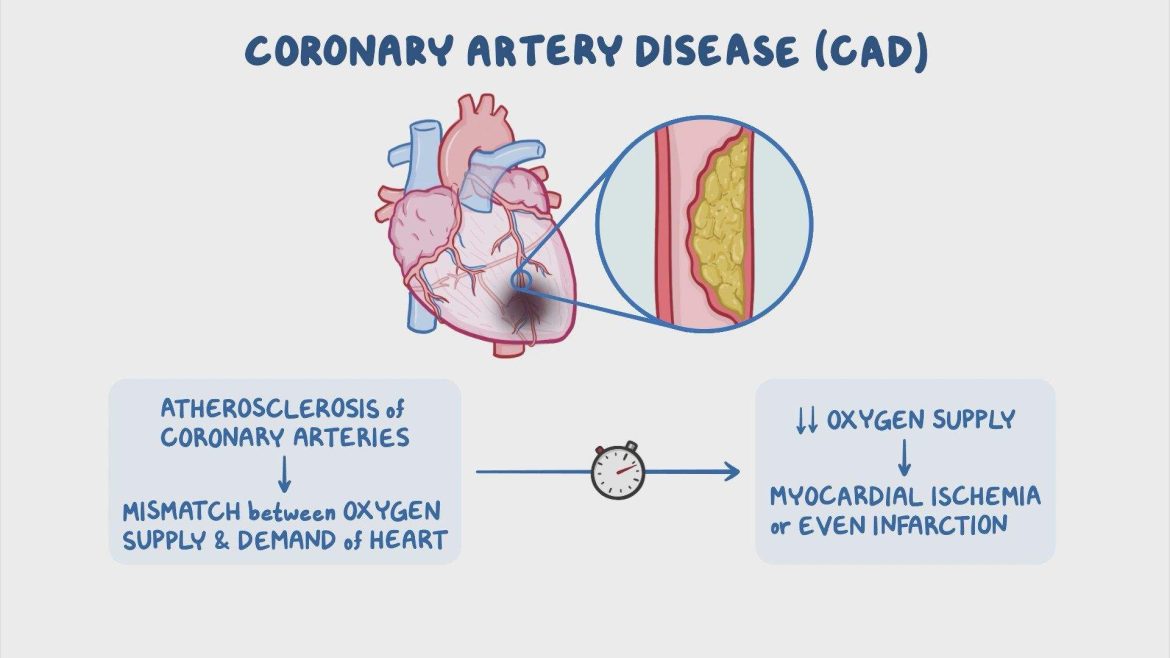Coronary Artery Disease (CAD) is a condition characterized by the narrowing or blockage of the coronary arteries due to the buildup of plaque, which is a combination of cholesterol, fatty deposits, and other substances. This disease significantly affects the heart’s ability to receive adequate blood flow, leading to various health complications. Understanding the side effects of CAD is crucial for patients and healthcare providers to manage and mitigate its impacts effectively.
1. Angina Pectoris
Definition and Types
Angina pectoris, commonly known as angina, is chest pain or discomfort that occurs when the heart muscle doesn’t get enough oxygen-rich blood. Angina can be classified into stable angina, unstable angina, and variant (Prinzmetal’s) angina:
Stable Angina: Predictable chest pain triggered by physical exertion or stress and relieved by rest or medication.
Unstable Angina: Unexpected chest pain that occurs at rest, indicating a higher risk of a heart attack.
Variant Angina: Rare and usually occurs at rest due to a spasm in the coronary arteries.
SEE ALSO: What Are The Types of Metal Angina?
Symptoms
- Chest pain or discomfort (pressure, squeezing, or fullness)
- Pain in the shoulders, arms, neck, jaw, or back
- Shortness of breath
- Sweating
- Nausea
- Fatigue
2. Heart Attack (Myocardial Infarction)
Mechanism
A heart attack occurs when a coronary artery becomes completely blocked, preventing oxygen-rich blood from reaching a section of the heart muscle. The blockage is usually caused by a ruptured plaque that forms a blood clot.
Symptoms
- Severe chest pain or discomfort
- Pain spreading to the shoulder, arm, back, neck, or jaw
- Shortness of breath
- Sweating
- Nausea or vomiting
- Lightheadedness or dizziness
- Rapid or irregular heartbeats
Complications
- Heart failure
- Arrhythmias (irregular heartbeats)
- Cardiogenic shock
- Sudden cardiac arrest
3. Heart Failure
Definition and Causes
Heart failure, also known as congestive heart failure (CHF), occurs when the heart is unable to pump blood efficiently to meet the body’s needs. CAD is a leading cause of heart failure due to the damage it inflicts on the heart muscle over time.
Symptoms
- Shortness of breath (dyspnea) during activities or while lying down
- Fatigue and weakness
- Swelling (edema) in the legs, ankles, and feet
- Rapid or irregular heartbeat
- Persistent cough or wheezing with white or pink blood-tinged mucus
- Increased need to urinate at night
- Swelling of the abdomen (ascites)
- Sudden weight gain from fluid retention
Management
- Lifestyle changes (diet, exercise, quitting smoking)
- Medications (ACE inhibitors, beta-blockers, diuretics)
- Devices (pacemakers, implantable cardioverter-defibrillators)
- Surgery (coronary artery bypass grafting, heart transplant)
4. Arrhythmias
Definition and Types
Arrhythmias are abnormal heart rhythms resulting from disruptions in the heart’s electrical impulses. CAD can lead to various types of arrhythmias, including:
Atrial Fibrillation: Rapid and irregular beating of the atria
Ventricular Tachycardia: Fast heart rhythm originating from the ventricles
Ventricular Fibrillation: Disorganized electrical activity causing the ventricles to quiver instead of pumping blood
Symptoms
- Palpitations (fluttering or pounding in the chest)
- Dizziness or lightheadedness
- Shortness of breath
- Chest pain or discomfort
- Fatigue
- Fainting (syncope) or near fainting
Complications
- Stroke
- Heart failure
- Sudden cardiac arrest
5. Sudden Cardiac Arrest
Mechanism and Risk Factors
Sudden cardiac arrest (SCA) occurs when the heart abruptly stops beating due to an electrical malfunction. CAD increases the risk of SCA, particularly in individuals with severe artery blockages or previous heart attacks.
Symptoms
- Sudden collapse
- No pulse
- No breathing
- Loss of consciousness
6. Peripheral Artery Disease
Definition and Connection to CAD
Peripheral artery disease (PAD) is a condition where the arteries that supply blood to the limbs are narrowed or blocked. CAD patients are at a higher risk of developing PAD due to the similar mechanisms of atherosclerosis.
Symptoms
- Leg pain or cramping during physical activity (claudication)
- Numbness or weakness in the legs
- Coldness in the lower leg or foot
- Sores on toes, feet, or legs that won’t heal
- Change in leg color
- Hair loss or slower hair growth on the feet and legs
Management
Lifestyle changes (diet, exercise, quitting smoking)
Medications (antiplatelet agents, cholesterol-lowering drugs)
Surgery (angioplasty, bypass surgery)
7. Stroke
Types and Connection to CAD
A stroke occurs when the blood supply to part of the brain is interrupted or reduced, depriving brain tissue of oxygen and nutrients. CAD increases the risk of ischemic strokes, which are caused by blood clots or plaque buildup.
Symptoms
Sudden numbness or weakness in the face, arm, or leg, especially on one side of the body
Sudden confusion, trouble speaking, or understanding speech
Sudden vision problems in one or both eyes
Sudden difficulty walking, dizziness, loss of balance, or coordination
Sudden severe headache with no known cause
Complications
Long-term disability
Difficulty with speech and language
Paralysis or weakness on one side of the body
Cognitive deficits
Emotional disturbances
8. Chronic Kidney Disease
Mechanism and Link to CAD
Chronic kidney disease (CKD) is characterized by a gradual loss of kidney function over time. CAD contributes to CKD due to reduced blood flow to the kidneys, which impairs their ability to filter waste from the blood.
Symptoms
- Fatigue
- Swelling in the feet and ankles
- Shortness of breath
- Persistent itching
- Changes in urination frequency and appearance
- High blood pressure
- Muscle cramps
Management
Medications (blood pressure-lowering drugs, cholesterol-lowering drugs)
Dialysis in advanced stages
Lifestyle changes (diet, exercise, managing diabetes)
Conclusion
Coronary Artery Disease has far-reaching side effects that impact various aspects of health and quality of life. From physical symptoms like angina, heart attacks, and heart failure to psychological effects such as depression and anxiety, CAD poses significant challenges. Effective management of CAD requires a comprehensive approach that includes lifestyle changes, medications, and, in some cases, surgical interventions.

